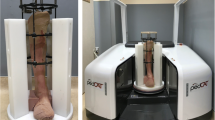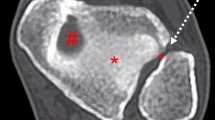Abstract
Purpose
Acute syndesmotic ankle injuries continue to impose a diagnostic dilemma and it remains unclear whether weightbearing and/or external rotation should be added during the imaging process. Therefore, the aim of this study was to assess if combined weightbearing and external rotation increases the diagnostic sensitivity of syndesmotic ankle instability using weightbearing CT (WBCT) imaging, compared to isolated weightbearing.
Methods
In this retrospective study, patients with an acute syndesmotic ankle injury were analysed using a WBCT (N = 21; Age = 31.6 ± 14.1 years old). Inclusion criteria were an MRI confirmed syndesmotic ligament injury imaged by a WBCT of the ankle during weightbearing and combined weightbearing-external rotation. Exclusion criteria consisted of fracture associated syndesmotic injuries. Three-dimensional (3D) models were generated from the CT slices. Tibiofibular displacement and talar rotation were quantified using automated 3D measurements (anterior tibiofibular distance (ATFD), Alpha angle, posterior Tibiofibular distance (PTFD) and Talar rotation (TR) angle in comparison to the contralateral non-injured ankle.
Results
The difference in neutral-stressed Alpha angle and ATFD showed a significant difference between patients with a syndesmotic ankle lesion and contralateral control (P = 0.046 and P = 0.039, respectively). The difference in neutral-stressed PTFD and TR angle did not show a significant difference between patients with a syndesmotic ankle lesion and healthy ankles (n.s.).
Conclusion
Application of combined weightbearing-external rotation reveals an increased ATFD in patients with syndesmotic ligament injuries. This study provides the first insights based on 3D measurements to support the potential relevance of applying external rotation during WBCT imaging. In clinical practice, this could enhance the current diagnostic accuracy of subtle syndesmotic instability in a non-invasive manner. However, to what extent certain displacement patterns require operative treatment strategies has yet to be determined in future studies.
Level of evidence
Level III.





Similar content being viewed by others
Explore related subjects
Discover the latest articles, news and stories from top researchers in related subjects.Data availability
The data that support the findings of this study are available upon reasonable request to the corresponding author M. Peiffer (email: matthias.peiffer@ugent.be). The dataset includes clinical CT scans, which contain sensitive patient information and cannot be shared due to privacy and ethical considerations. However, all measurement results derived from the analysis of these CT scans, as presented in the manuscript, can be accessed and provided upon request.
References
Ashkani Esfahani S, Bhimani R, Lubberts B, Kerkhoffs GM, Waryasz G, DiGiovanni CW et al (2022) Volume measurements on weightbearing computed tomography can detect subtle syndesmotic instability. J Orthop Res 40:460–467
Barg A, Bailey T, Richter M, de Cesar NC, Lintz F, Burssens A et al (2018) Weightbearing computed tomography of the foot and ankle: emerging technology topical review. Foot Ankle Int 39:376–386
Beisemann N, Tilk AM, Gierse J, Grutzner PA, Franke J, Siewerdsen JH et al (2022) Detection of fibular rotational changes in cone beam CT: experimental study in a specimen model. BMC Med Imaging 22:181. https://doi.org/10.1186/s12880-022-00913-3
Beumer A, van Hemert WL, Niesing R, Entius CA, Ginai AZ, Mulder PG et al (2004) Radiographic measurement of the distal tibiofibular syndesmosis has limited use. Clin Orthop Relat Res 423:227–234
Bhimani R, Ashkani-Esfahani S, Lubberts B, Guss D, Hagemeijer NC, Waryasz G et al (2020) Utility of volumetric measurement via weight-bearing computed tomography scan to diagnose syndesmotic instability. Foot Ankle Int 41:859–865
Burssens A, Krahenbuhl N, Weinberg MM, Lenz AL, Saltzman CL, Barg A (2020) Comparison of external torque to axial loading in detecting 3-dimensional displacement of syndesmotic ankle injuries. Foot Ankle Int 41:1256–1268
Burssens A, Peeters J, Peiffer M, Marien R, Lenaerts T, Wbct ISG et al (2018) Reliability and correlation analysis of computed methods to convert conventional 2D radiological hindfoot measurements to a 3D setting using weightbearing CT. Int J Comput Assist Radiol Surg 13:1999–2008
Calder JD, Bamford R, Petrie A, McCollum GA (2016) Stable versus unstable grade II high ankle sprains: a prospective study predicting the need for surgical stabilization and time to return to sports. Arthroscopy 32:634–642
Campbell T, Mok A, Wolf MR, Tarakemeh A, Everist B, Vopat BG (2022) Augmented stress weightbearing CT for evaluation of subtle tibiofibular syndesmotic injuries in the elite athlete. Skeletal Radiol. https://doi.org/10.1007/s00256-022-04229-9
Clanton TO, Williams BT, Backus JD, Dornan GJ, Liechti DJ, Whitlow SR et al (2017) Biomechanical analysis of the individual ligament contributions to syndesmotic stability. Foot Ankle Int 38:66–75
de Cesar PC, Avila EM, de Abreu MR (2011) Comparison of magnetic resonance imaging to physical examination for syndesmotic injury after lateral ankle sprain. Foot Ankle Int 32:1110–1114
Gerber JP, Williams GN, Scoville CR, Arciero RA, Taylor DC (1998) Persistent disability associated with ankle sprains: a prospective examination of an athletic population. Foot Ankle Int 19:653–660
Grossterlinden LG, Hartel M, Yamamura J, Schoennagel B, Burger N, Krause M et al (2016) Isolated syndesmotic injuries in acute ankle sprains: diagnostic significance of clinical examination and MRI. Knee Surg Sports Traumatol Arthrosc 24:1180–1186
Hagemeijer NC, Lubberts B, Saengsin J, Bhimani R, Sato G, Waryasz GR et al (2023) Portable dynamic ultrasonography is a useful tool for the evaluation of suspected syndesmotic instability: a cadaveric study. Knee Surg Sports Traumatol Arthrosc 31:1986–1993
Harper MC (2001) Delayed reduction and stabilization of the tibiofibular syndesmosis. Foot Ankle Int 22:15–18
Hunt KJ, Phisitkul P, Pirolo J, Amendola A (2015) High ankle sprains and syndesmotic injuries in athletes. J Am Acad Orthop Surg 23:661–673
Huysse W, Burssens A, Peiffer M, Cornelis B, Stufkens SAS, Kerkhoffs G et al (2021) Morphometric analysis of the incisura fibularis in patients with unstable high ankle sprains. Skeletal Radiol 50:1141–1150
Kikuchi S, Tajima G, Sugawara A, Yan J, Maruyama M, Oikawa S et al (2020) Characteristic features of the insertions of the distal tibiofibular ligaments on three-dimensional computed tomography- cadaveric study. J Exp Orthop 7:3. https://doi.org/10.1186/s40634-020-0220-6
Krahenbuhl N, Akkaya M, Dodd AE, Hintermann B, Dutilh G, Lenz AL et al (2020) Impact of the rotational position of the hindfoot on measurements assessing the integrity of the distal tibio-fibular syndesmosis. Foot Ankle Surg 26:810–817
Krahenbuhl N, Weinberg MW, Davidson NP, Mills MK, Hintermann B, Saltzman CL et al (2018) Imaging in syndesmotic injury: a systematic literature review. Skeletal Radiol 47:631–648
Kvarda P, Krahenbuhl N, Susdorf R, Burssens A, Ruiz R, Barg A et al (2022) High reliability for semiautomated 3D measurements based on weightbearing CT scans. Foot Ankle Int 43:91–95
Lei Q, Chen P, He X, Xu Z, He W (2023) Preoperative CT parameters to predict tibiofibular syndesmosis injury associated with ankle fracture: a propensity score-matched analysis. Eur J Trauma Emerg Surg. https://doi.org/10.1007/s00068-023-02256-2
Lepojarvi S, Niinimaki J, Pakarinen H, Koskela L, Leskela HV (2016) Rotational dynamics of the talus in a normal tibiotalar joint as shown by weight-bearing computed tomography. J Bone Joint Surg Am 98:568–575
Lepojarvi S, Niinimaki J, Pakarinen H, Leskela HV (2016) Rotational dynamics of the normal distal tibiofibular joint with weight-bearing computed tomography. Foot Ankle Int 37:627–635
Lintz F, de Cesar NC, Barg A, Burssens A, Richter M, Weight Bearing CTISG (2018) Weight-bearing cone beam CT scans in the foot and ankle. EFORT Open Rev 3:278–286
Patel S, Malhotra K, Cullen NP, Singh D, Goldberg AJ, Welck MJ (2019) Defining reference values for the normal tibiofibular syndesmosis in adults using weight-bearing CT. Bone Joint J 101:348–352
Peiffer M, Burssens A, De Mits S, Heintz T, Van Waeyenberge M, Buedts K et al (2022) Statistical shape model-based tibiofibular assessment of syndesmotic ankle lesions using weight-bearing CT. J Orthop Res. https://doi.org/10.1002/jor.25318
Peiffer M, Burssens A, Duquesne K, Last M, De Mits S, Victor J et al (2022) Personalised statistical modelling of soft tissue structures in the ankle. Comput Methods Programs Biomed 218:106701
Peiffer M, Duquesne K, Van Oevelen A, Burssens A, De Mits S, Maas SA et al (2023) Validation of a personalized ligament-constraining discrete element framework for computing ankle joint contact mechanics. Comput Methods Programs Biomed 231:107366. https://doi.org/10.1016/j.cmpb.2023.107366
Richter M, Lintz F, de Cesar NC, Barg A, Burssens A (2020) Results of more than 11,000 scans with weightbearing CT - Impact on costs, radiation exposure, and procedure time. Foot Ankle Surg 26:518–522
Rodrigues JC, do Amaral ECA, Rosemberg LA, de Cesar NC, Godoy-Santos AL (2023) diagnostic accuracy of conventional ankle CT scan with external rotation and dorsiflexion in patients with acute isolated syndesmotic instability. Am J Sports Med 51:985–996
Roemer FW, Jomaah N, Niu J, Almusa E, Roger B, D’Hooghe P et al (2014) Ligamentous injuries and the risk of associated tissue damage in acute ankle sprains in athletes: a cross-sectional MRI study. Am J Sports Med 42:1549–1557
Shakoor D, Osgood GM, Brehler M, Zbijewski WB, de Cesar NC, Shafiq B et al (2019) Cone-beam CT measurements of distal tibio-fibular syndesmosis in asymptomatic uninjured ankles: does weight-bearing matter? Skeletal Radiol 48:583–594
Tampere T, D’Hooghe P (2021) The ankle syndesmosis pivot shift “are we reviving the ACL story?” Knee Surg Sports Traumatol Arthrosc 29:3508–3511
van Dijk CN, Longo UG, Loppini M, Florio P, Maltese L, Ciuffreda M et al (2016) Classification and diagnosis of acute isolated syndesmotic injuries: ESSKA-AFAS consensus and guidelines. Knee Surg Sports Traumatol Arthroscop 24:1200–1216
Waterman BR, Owens BD, Davey S, Zacchilli MA, Belmont PJ Jr (2010) The epidemiology of ankle sprains in the United States. J Bone Joint Surg Am 92:2279–2284
Zaidi R, Sangoi D, Cullen N, Patel S, Welck M, Malhotra K (2023) Semi-automated 3-dimensional analysis of the normal foot and ankle using weight bearing CT - A report of normal values and bony relationships. Foot Ankle Surg 29:111–117
Funding
Matthias Peiffer was financially supported by PhD grant (1120220N) from the Research Foundation Flanders (FWO). Emmanuel Audenaert was financially supported by a senior clinical research fellowship (1842619N) from the Research Foundation Flanders. All authors declared no conflict of interest.
Author information
Authors and Affiliations
Contributions
All authors contributed equally to this article. MP designed, coordinated and co-drafted the final manuscript. TD performed the data analysis and reviewed the final manuscript. FC performed the data collection and reviewed the final manuscript. TT helped with data collection and reviewed the manuscript. SAE co-managed the data interpretation and reviewed the final manuscript. PD co-designed the research hypothesis reviewed the final manuscript. EA supervised drafting of the manuscript. AB designed, coordinated and co-drafted the final manuscript. All authors read and approved the final manuscript.
Corresponding author
Ethics declarations
Conflict of interest
Matthias Peiffer, MD, has nothing to disclose; Thibaut Dhont, BSc, has nothing to disclose; Francis Cuigniez, MD, has nothing to disclose; Thomas Tampere, MD, has nothing to disclose; S. Ashkani-Esfahani, MD, has nothing to disclose; Pieter D’Hooghe, MD, PhD, has nothing to disclose; Emmanuel Audenaert, MD, PhD, has nothing to disclose; Arne Burssens, MD, PhD, has nothing to disclose.
Ethical approval
IRB:EC 2019/0887 (Institutional Review Board of University Hospital Ghent).
Informed consent
None
Additional information
Publisher's Note
Springer Nature remains neutral with regard to jurisdictional claims in published maps and institutional affiliations.
Rights and permissions
Springer Nature or its licensor (e.g. a society or other partner) holds exclusive rights to this article under a publishing agreement with the author(s) or other rightsholder(s); author self-archiving of the accepted manuscript version of this article is solely governed by the terms of such publishing agreement and applicable law.
About this article
Cite this article
Peiffer, M., Dhont, T., Cuigniez, F. et al. Application of external torque enhances the detection of subtle syndesmotic ankle instability in a weight-bearing CT. Knee Surg Sports Traumatol Arthrosc 31, 4886–4894 (2023). https://doi.org/10.1007/s00167-023-07536-3
Received:
Accepted:
Published:
Issue Date:
DOI: https://doi.org/10.1007/s00167-023-07536-3




